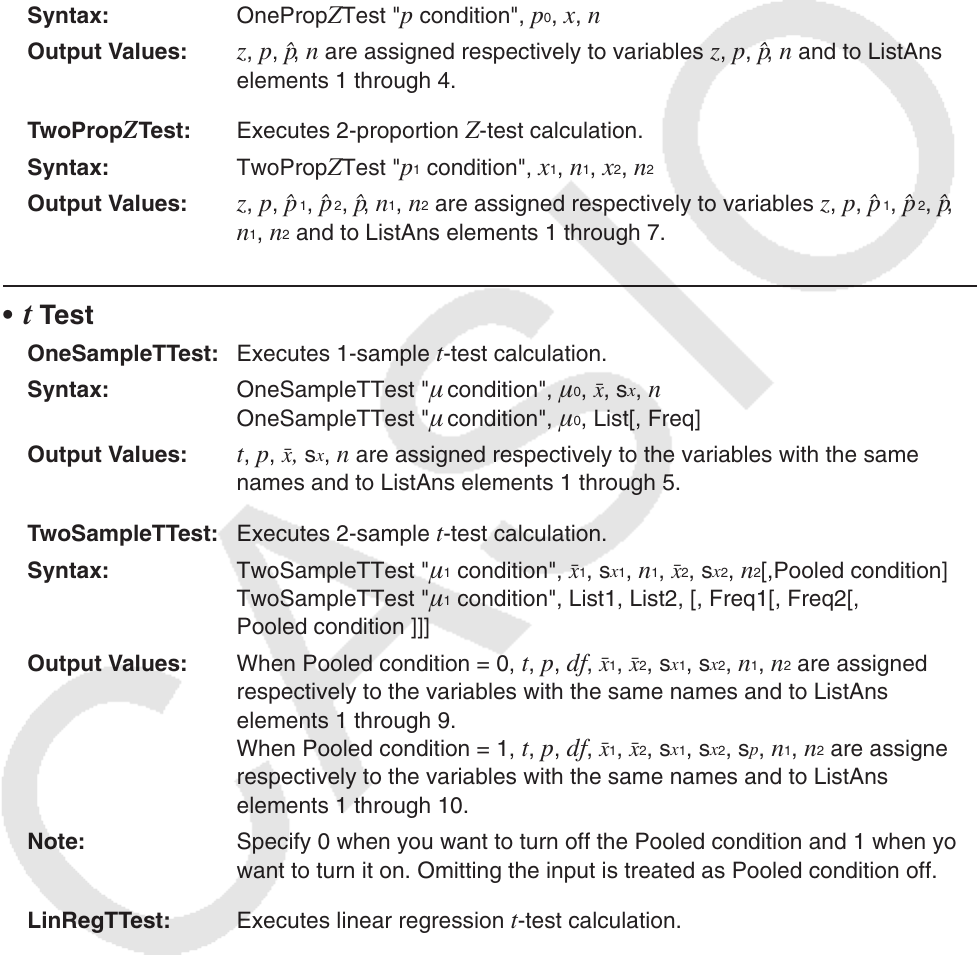User Manual
Table Of Contents
- Contents
- Getting Acquainted — Read This First!
- Chapter 1 Basic Operation
- Chapter 2 Manual Calculations
- 1. Basic Calculations
- 2. Special Functions
- 3. Specifying the Angle Unit and Display Format
- 4. Function Calculations
- 5. Numerical Calculations
- 6. Complex Number Calculations
- 7. Binary, Octal, Decimal, and Hexadecimal Calculations with Integers
- 8. Matrix Calculations
- 9. Vector Calculations
- 10. Metric Conversion Calculations
- Chapter 3 List Function
- Chapter 4 Equation Calculations
- Chapter 5 Graphing
- 1. Sample Graphs
- 2. Controlling What Appears on a Graph Screen
- 3. Drawing a Graph
- 4. Saving and Recalling Graph Screen Contents
- 5. Drawing Two Graphs on the Same Screen
- 6. Manual Graphing
- 7. Using Tables
- 8. Modifying a Graph
- 9. Dynamic Graphing
- 10. Graphing a Recursion Formula
- 11. Graphing a Conic Section
- 12. Drawing Dots, Lines, and Text on the Graph Screen (Sketch)
- 13. Function Analysis
- Chapter 6 Statistical Graphs and Calculations
- 1. Before Performing Statistical Calculations
- 2. Calculating and Graphing Single-Variable Statistical Data
- 3. Calculating and Graphing Paired-Variable Statistical Data (Curve Fitting)
- 4. Performing Statistical Calculations
- 5. Tests
- 6. Confidence Interval
- 7. Distribution
- 8. Input and Output Terms of Tests, Confidence Interval, and Distribution
- 9. Statistic Formula
- Chapter 7 Financial Calculation
- Chapter 8 Programming
- Chapter 9 Spreadsheet
- Chapter 10 eActivity
- Chapter 11 Memory Manager
- Chapter 12 System Manager
- Chapter 13 Data Communication
- Chapter 14 Geometry
- Chapter 15 Picture Plot
- Chapter 16 3D Graph Function
- Appendix
- Examination Mode
- E-CON4 Application (English)
- 1. E-CON4 Mode Overview
- 2. Sampling Screen
- 3. Auto Sensor Detection (CLAB Only)
- 4. Selecting a Sensor
- 5. Configuring the Sampling Setup
- 6. Performing Auto Sensor Calibration and Zero Adjustment
- 7. Using a Custom Probe
- 8. Using Setup Memory
- 9. Starting a Sampling Operation
- 10. Using Sample Data Memory
- 11. Using the Graph Analysis Tools to Graph Data
- 12. Graph Analysis Tool Graph Screen Operations
- 13. Calling E-CON4 Functions from an eActivity

8-47
TwoSample Z Test: Executes 2-sample Z -test calculation.
Syntax: TwoSample
Z Test "
1
condition",
σ
1
,
σ
2
, o
1
, n
1
, o
2
, n
2
Output Values: z , p , o
1
, o
2
, n
1
, n
2
are assigned respectively to variables z , p , o
1
, o
2
, n
1
, n
2
and to ListAns elements 1 through 6.
Syntax: TwoSample
Z Test "
1
condition",
σ
1
,
σ
2
, List1, List2[, Freq1 [, Freq2]]
Output Values:
z , p , o
1
, o
2
,
s
x
1
, s
x
2
, n
1
, n
2
are assigned respectively to variables z , p , o
1
, o
2
,
s
x
1
, s
x
2
, n
1
, n
2
and to ListAns elements 1 through 8.
OneProp Z Test: Executes 1-proportion Z -test calculation.
Syntax: OneProp
Z Test " p condition", p
0
, x , n
Output Values: z , p , pˆ , n are assigned respectively to variables z , p , pˆ , n and to ListAns
elements 1 through 4.
TwoProp Z Test: Executes 2-proportion Z -test calculation.
Syntax: TwoProp
Z Test " p
1
condition", x
1
, n
1
, x
2
, n
2
Output Values: z , p , pˆ
1
, pˆ
2
, pˆ , n
1
, n
2
are assigned respectively to variables z , p , pˆ
1
, pˆ
2
, pˆ ,
n
1
, n
2
and to ListAns elements 1 through 7.
• t Test
OneSampleTTest: Executes 1-sample t -test calculation.
Syntax: OneSampleTTest "
condition",
0
, o, s
x
, n
OneSampleTTest "
condition",
0
, List[, Freq]
Output Values:
t , p , o, s
x
, n are assigned respectively to the variables with the same
names and to ListAns elements 1 through 5.
TwoSampleTTest: Executes 2-sample t -test calculation.
Syntax: TwoSampleTTest "
1
condition", o
1
, s
x
1
, n
1
, o
2
, s
x
2
, n
2
[,Pooled condition]
TwoSampleTTest "
1
condition", List1, List2, [, Freq1[, Freq2[,
Pooled condition ]]]
Output Values: When Pooled condition = 0,
t, p, df, o
1
, o
2
, s
x
1
, s
x
2
, n
1
, n
2
are assigned
respectively to the variables with the same names and to ListAns
elements 1 through 9.
When Pooled condition = 1, t , p , df , o
1
, o
2
, s
x
1
, s
x
2
, s
p
, n
1
, n
2
are assigned
respectively to the variables with the same names and to ListAns
elements 1 through 10.
Note: Specify 0 when you want to turn off the Pooled condition and 1 when you
want to turn it on. Omitting the input is treated as Pooled condition off.
LinRegTTest: Executes linear regression t -test calculation.
Syntax: LinRegTTest "
&
ρ
condition", XList, YList[, Freq]
Output Values:
t , p , df , a, b, s, r, r
2
are assigned respectively to the variables with the
same names and to ListAns elements 1 through 8.










